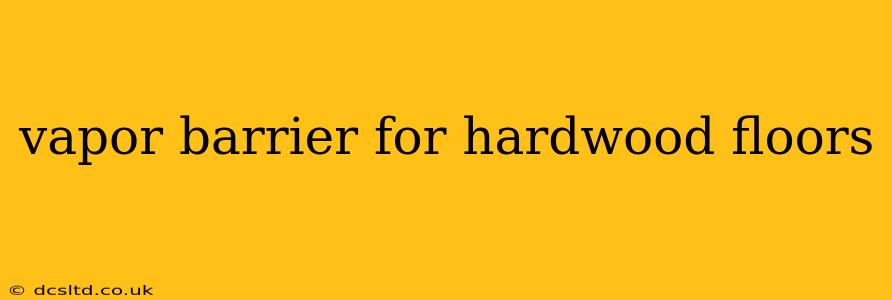Hardwood floors are a beautiful and valuable addition to any home, but their longevity and performance depend heavily on proper installation, including the use of a vapor barrier. Understanding when and how to use a vapor barrier is crucial for preventing costly damage and ensuring your floors remain stunning for years to come. This guide will cover everything you need to know about vapor barriers and hardwood floors.
What is a Vapor Barrier?
A vapor barrier is a material designed to prevent moisture vapor from passing through it. In the context of hardwood flooring, it acts as a shield against moisture rising from the subfloor, typically from concrete slabs. This moisture can cause a range of problems, including:
- Cupping: The edges of the wood planks curl upwards.
- Crowning: The center of the planks rises, creating a dome-like effect.
- Buckling: The planks warp and lift significantly, potentially causing damage to the floor and requiring extensive repairs.
- Mold and Mildew Growth: Moisture trapped beneath the floor provides an ideal environment for mold and mildew, leading to health problems and structural damage.
When Do You Need a Vapor Barrier for Hardwood Floors?
The need for a vapor barrier depends largely on your subfloor and climate. Here's a breakdown:
-
Concrete Subfloors: Concrete is porous and can release moisture vapor, especially in humid climates or basements. A vapor barrier is almost always recommended for hardwood floors installed over concrete.
-
Wood Subfloors: Wood subfloors are generally less prone to moisture problems than concrete, but a vapor barrier might still be necessary if the subfloor is located in a damp environment, or if there's a risk of moisture intrusion from below.
-
Climate: High humidity climates require more attention to moisture control. Even with a wood subfloor, a vapor barrier can be beneficial in these regions.
-
High Moisture Levels: If you've experienced previous moisture problems in your home, using a vapor barrier is highly recommended. A moisture meter test can help determine the moisture content of your subfloor.
What Types of Vapor Barriers are Used for Hardwood Floors?
Several materials serve as effective vapor barriers:
-
6-mil Polyethylene Sheeting: This is a common and relatively inexpensive option, readily available at most home improvement stores. It's important to overlap the sheets and seal the seams properly with tape designed for this purpose.
-
Vapor Barrier Paint: This specialized paint creates a continuous, sealed surface. It's suitable for smaller areas or situations where sheeting might be difficult to install.
-
Other Materials: Other products such as foam insulation with integrated vapor barriers are also available and offer additional benefits like insulation.
How to Install a Vapor Barrier for Hardwood Floors
Proper installation is vital to ensure the vapor barrier's effectiveness.
-
Clean the Subfloor: Thoroughly clean the subfloor to remove debris and ensure a smooth, even surface for the vapor barrier.
-
Lay the Vapor Barrier: Overlap the sheets by at least 6 inches and seal the seams using vapor-resistant tape. Ensure the vapor barrier extends beyond the perimeter of the hardwood flooring.
-
Secure the Vapor Barrier: Weight down the edges of the vapor barrier to prevent it from shifting during installation.
-
Install Underlayment (if applicable): Many hardwood flooring installations benefit from an underlayment, which provides additional cushioning, sound insulation, and moisture protection. This is installed on top of the vapor barrier.
-
Install Hardwood Flooring: Once the underlayment (if used) is in place, you can proceed with installing your hardwood flooring.
What happens if you don't use a vapor barrier?
Neglecting to install a vapor barrier can lead to significant problems as mentioned earlier, including cupping, crowning, buckling, and mold growth. These problems can be incredibly costly to repair, often requiring the complete replacement of the flooring.
Can I use a vapor barrier with engineered hardwood?
Yes, a vapor barrier can and should be used with engineered hardwood, especially if installed over concrete. Engineered hardwood is still susceptible to moisture damage.
What is the best vapor barrier for hardwood floors?
There's no single "best" vapor barrier. The ideal choice depends on your budget, the specific conditions of your subfloor and climate, and personal preferences. 6-mil polyethylene sheeting is a popular and effective option, but other materials may be preferable in certain circumstances.
This guide provides a comprehensive overview of vapor barriers for hardwood floors. Remember to always consult with a flooring professional for specific advice regarding your project. Proper planning and installation will ensure your beautiful hardwood floor remains in excellent condition for many years to come.
